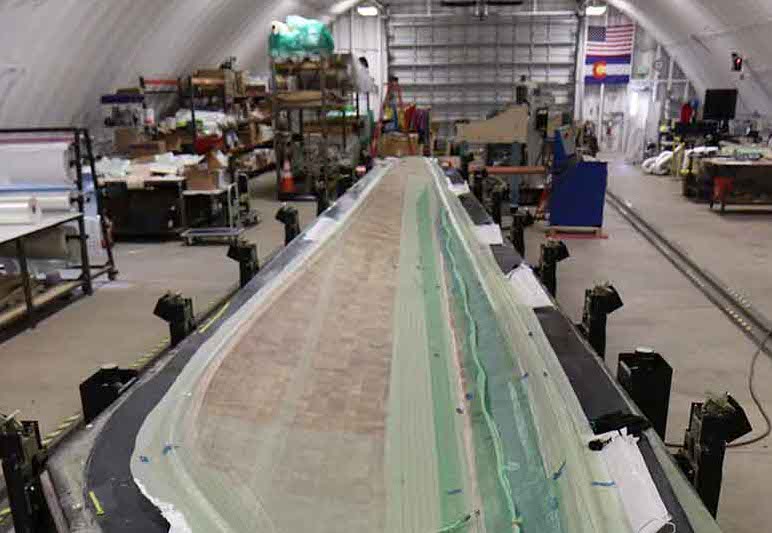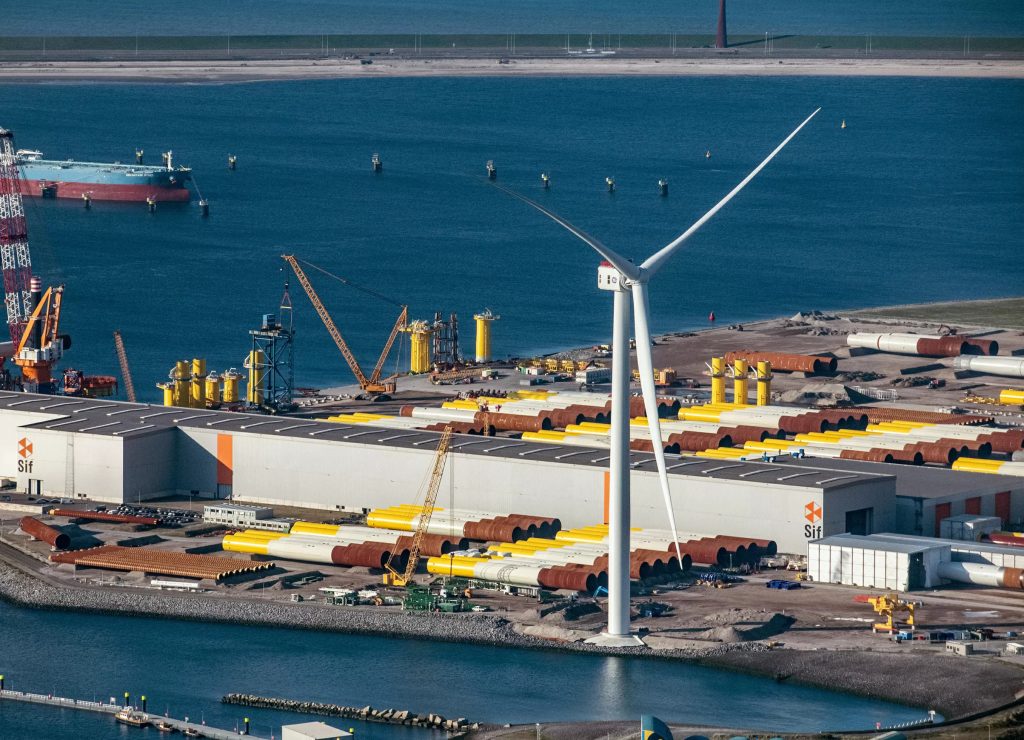Researchers at the U.S. National Renewable Energy Laboratory (NREL) have developed a novel way of manufacturing wind turbine blades that improves both their performance and end-of-life recyclability.
Rather than creating blades from normal thermoset resins, the team has devised a unique set up for 3D printing them using thermoplastics, which can later be heated to recover their original polymers for reuse. Putting their approach into practise, the engineers have already managed to fabricate a 13-meter prototype, and in future, they believe the process could yield cost and speed gains for manufacturers.

“Revolutionizing” blade design
At present, many utility-scale wind turbine blades feature a similar clamshell-like design, in which two fiberglass ‘skins’ are bonded together with adhesives, and stiffened using shear webs. However, these large-format parts tend to be produced with thermoset resins like epoxies, polyesters and vinyl esters that, once cured, irreversibly cross-link in a way that makes their plastics impossible to reuse.
“Once you produce a blade with a thermoset resin system, you cannot reverse the process,” explains Derek Berry, the NREL project’s lead. “That makes the blade difficult to recycle.” What’s more, according to the NREL itself, the process may have been tweaked for efficiency gains over the last 25 years, but it has actually changed very little, thus turbines aren’t built in a way that matches their sustainable image.
Given that earlier this year, President Biden set an ambitious target of cutting U.S. greenhouse emissions in half by 2030, and highlighted ‘green energy technologies’ as being vital to achieving this, the NREL researchers have now identified the need for a revamp that “revolutionizes how wind turbine blades are manufactured.”
NREL’s CoMET makes an impact
To make blade production more circular, Berry and his team have embarked on a project with colleagues at the NREL’s Composites Manufacturing Education and Technology or ‘CoMET’ facility. Opened in 2017, the complex specializes in advancing the R&D of wind, waterpower and composite technologies, by providing users with access to 3D printed tooling, composite mixing equipment and prototyping tools.
In the case of Berry’s project, which is backed by the U.S. Department of Energy’s Advanced Manufacturing Office, he and his team have managed to develop a system capable of processing recyclable thermoplastics. These can then be used to print more circular blades, which are attachable to other parts via thermal welding, in a process that removes the need for often-toxic and costly adhesives.
By switching from conventional manufacturing methods to 3D printing, the multi-disciplinary team have also been able to produce more advanced blades with highly-engineered, net-shaped structures that feature varying densities and geometries between their ‘skins,’ which can themselves, be infused using a thermoplastic resin system.
“With two thermoplastic blade components, you have the ability to bring them together and, through the application of heat and pressure, join them. You cannot do that with thermoset materials.”
Leveraging their novel set up, Berry and his team have already been able to build a 13-meter thermoplastic prototype at the NREL’s CoMET facility, which takes full advantage of these 3D printing-related benefits.
Working with partners TPI Composites, Additive Engineering Solutions, Ingersoll Machine Tools, Vanderbilt University and the Institute for Advanced Composites Manufacturing Innovation, the researchers believe that in future, it could be possible to reduce the weight and cost of turbine blades by 10%, and their lead times by 15%, while developing lightweighted parts up to 100 meters in length.
Additionally, when the NREL’s research received funding earlier this year, it was backed alongside two subgrant projects, which are also investigating 3D printing’s turbine blade potential. While Colorado State University is currently working on fiber-reinforced composites for creating novel internal blade structures, GE Research is developing a fully-sized 3D printed blade tip for structural testing.

AM-enhanced clean energy
As the world begins to turn towards offshore energy solutions to combat the global climate crisis, a significant amount of research is now being poured into making wind turbines themselves more eco-friendly. Engineers at McGill University and Ryerson University have developed a means of converting wind turbine blade waste into a novel 3D printable PLA, capable of yielding fiber-reinforced parts.
Earlier this year, the University of Maine also secured $2.8 million in federal funding, to support its development of an eco-friendly turbine blade mold 3D printing process. Also backed by Ingersoll Machine Tools, much like the NREL team’s project, UMaine’s research has focused more on the use of bio-based feedstock instead, with which it could be possible to halve the cost of creating large parts.
Over in Germany meanwhile, Fraunhofer IGCV and voxeljet have set out to advance the scale of 3D printed wind turbine blades, rather than focus specifically on improving their circularity. To accomplish this, the two organizations are working on an ‘Advance Casting Cell’ that’s capable of producing the molds needed to cast parts for GE’s Haliade-X turbine, which can weigh up to 60 tons each.
To stay up to date with the latest 3D printing news, don’t forget to subscribe to the 3D Printing Industry newsletter or follow us on Twitter or liking our page on Facebook.
For a deeper dive into additive manufacturing, you can now subscribe to our Youtube channel, featuring discussion, debriefs, and shots of 3D printing in-action.
Are you looking for a job in the additive manufacturing industry? Visit 3D Printing Jobs for a selection of roles in the industry.
Featured image shows a portion of the NREL researchers’ 13-meter thermoplastic blade prototype. Photo via Ryan Beach, the NREL.



